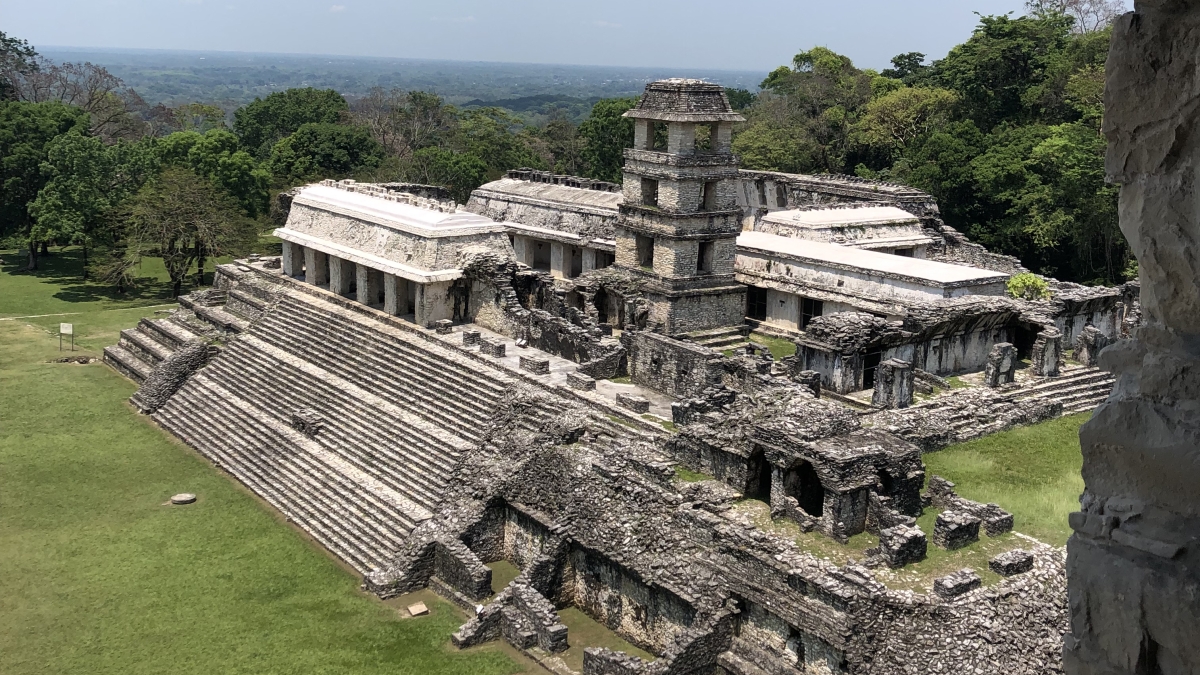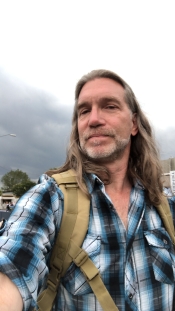ASU archaeologist helps discover ancient Maya city with National Geographic

Ancient Palace complex at Palenque, which may have been settled by the Maya from Mensabak, Chiapas, Mexico. Photo courtesy of Joel Palka
Known in the world of archaeology for his storied expertise and knowledge of Maya history and culture, Joel Palka was still excited to get a call from National Geographic.
Palka is an associate professor at the School of Human Evolution and Social Change at Arizona State University. In spring 2023, Palka was recruited by National Geographic researchers to participate in a filming for an episode of “Lost Cities Revealed with Albert Lin.”
He said it took about three months to scout locations, research and film the episode “Cradle of the Maya.”
“I created the storyline with the Maya origin city at Mensabak, and its connections to the later site of Palenque and the contemporary Lacandon Maya in the region,” said Palka. “I provided all the archaeological evidence for the story and where to find it in the field. I had to help with the filming of all the sites and provide the evidence for the accuracy of the episode.”
“My 30-plus years of Maya archaeology and art studies really came in handy.”
ASU News spoke with Palka about the filming experience. Palka will be presenting the episode and answering questions for ASU students, faculty and staff on Thursday, Feb. 22.
Question: How did you become involved with this project?
Answer: A National Geographic researcher for “Lost Cities Revealed with Albert Lin” contacted me two years ago about a reported Maya lost city in Chiapas, Mexico. I said, "It’s not a city, and you won’t like the location for a video shoot. So come to Mensabak, Chiapas, where we have an unreported Maya city in a beautiful location."
The video’s director looked at Mensabak and Palenque locations and researched my project online. The director told the researcher, "Switch projects: We’re going to Mensabak!" And the rest is history.
Episode viewing and Q&A
When: 2–4 p.m. Thursday, Feb. 22,
Where: Tempe campus
Cowden Family Resources Building, room 124
850 S. Cady Mall
Tempe, AZ 85281
Register: https://na.eventscloud.com/natgeopalka
Q: What was it like working with Albert Lin and National Geographic?
A: It was very interesting and fun. They organized the airborne LiDAR laser mapping to see the landscape and Maya archaeology sites through the jungle canopy, and I worked on the storyline and explored the sites on the ground. The National Geographic team wanted the video project to be academically sound, so they required lots of background information, such as Maya hieroglyphic evidence and cultural details.
Q: Were discoveries made during this episode, or are we seeing "Hollywood magic"?
A: We actually made discoveries. The LiDAR team did several evening revealing scenes, so the surprises would be filmed. We also filmed these scenes with the Lacandon Maya living at Mensabak, who were completely surprised with the results. We also discovered an archaeological site near a cenote (a sinkhole filled with water) that no one knew about. The Hollywood magic came in with the professional photography and filming the archaeology technology, like the drone mapping and computer simulations of the Maya sites.
Q: Did anything surprise you during this project?
A: What surprised me was the amount of supporting scientific and cultural information that the National Geographic team wanted to back up the reconstruction of the Mensabak Maya origin city of Noh K’uh and its connections to the later Maya city of Palenque. It was like getting the project results through peer-review for a journal. I was also surprised with the state-of-the-art drone and hand-held LiDAR devices, and the latest computer hardware for the on-screen reconstructions of Maya sites and solar observations.
Q: What’s next for you? Any more TV appearances?
A: I’m waiting for a call from Ridley Scott to film a futuristic archaeology movie on another planet — just kidding! I want to teach my classes, work with my graduate students and return to Mensabak this summer to excavate. However, my project at Mensabak was also recently filmed for an educational video in Chiapas, and that will come out in Mexico soon. Video and technology are part of the future of archaeology.
I want to add that the Mensabak Lacandon Maya community and my project colleagues were very helpful during the making of the video. It could not have been done without them. Additionally, the filming, and the preparations for it, were some of the most interesting times in my archaeological career.
More Local, national and global affairs

ASU's USAID projects provided economic benefits to US
For more than a decade, Arizona State University has helped people around the world — and advanced interests in the United States at the same time — through its collaborative projects with the U.S.…

ASU champions veterans' success and national security
Arizona State University has a long history of supporting the military — whether through veteran education, groundbreaking research that improves their well-being, or innovative programs that…

ASU named a top producer of faculty, student Fulbright awards for 2024–25
When faculty and students travel abroad on a Fulbright award, they’re often working at the forefront of current events and cultural change.David Androff, a professor in the School of Social Work at…


